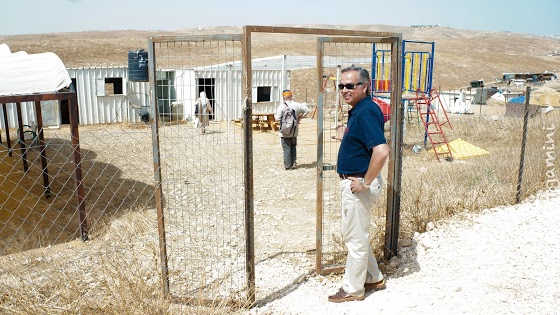JERUSALEM – A comeback on the nursery school in a Bedouin camp in the Judean Desert with the Combonian sisters: a dramatic reality on the ground, often ignored, on the sideline of the society.
The appointment was fixed near Maale Adumim settlement, on the road running downhill from Jerusalem to Jericho. Sr Azezet and Sr Agnes arrived in a jeep, the only way to travel easily through the desert and gave a ride to a small team made of Andrea and Lorenzo, two brothers from the Family of the Visitation, Henrique Abreu, in charge of LPJ projects, and Sr Azezet’s niece.
After Maale Adumim and the settlement of Kedar, they went through the Judean desert next to the famous Muntar Hill, not far from the Monastery of Mar Saba, where the natural scenery is gratifying with sand dunes blending with old stones and thorns with wild herbs. At their final destination they discovered a combination of tents, sheds and shacks for sheep: that’s where the Bedouins live. It is there that the sisters founded their nursery school.
 |
Local families come from seven Bedouin communities who used to live on hilltops in the east of Jerusalem, a desert area, with only richness consisting of seven water springs. There in the 60s, Maale Adumim was built illegally (beyond the Green Line). It houses now more than 50 000 inhabitants. These seven Bedouin communities, swept out, started roaming about in the adjoining valleys. Today, the communities are spread over some ten camps and live in unstable social and working conditions.
Some time ago, after years of legal battles, the High Court realized the serious consequences of laying hands on seven fountains belonging to these communities. In spite of a decision in their favor, these communities remain marginal to two settlements, which endeavor to drive them out yet farther, and also to Palestinian society, rendering their integration a very difficult task.
Five years ago, the Combonian Sisters decided to explore this reality. They came back to live in the village of Azareyah within a home, in the vicinity of Lazarus Tomb, separated now by the Wall, finished some years ago, that cuts them off from their mother house in Bethany which remains in the area of Jerusalem. They work as a team since then, together with Rabbis for Human Rights and with NGO “Vent de Terre” by going on visits to the most remote Bedouin communities.
An enduring work was launched through many visits in order to broaden the acquaintances, to start new friendships and to explore the needs of these people. The Sisters thus became full members of the larger Bedouin family. They focused on two basic aspects: health and education. A mobile clinic run by the Palestinian Ministry of Health, goes from one village to another to provide care for the sick, including vaccination of children and follow-up of pregnant mothers. Some Bedouin women became auxiliary nurses and three of them were hired by the Palestinian Ministry of Health to work in the Azareyah-based regular clinic. .
For education, the sisters relied on help of village women. They secured the training of some of them to become schoolteachers for their children, three for each school. There are now seven schools embracing around 25 children each in the villages of Al Muntar, Tabana, Anata, Abu Hindi, Al Jabal, Abu Nawar I, Abu Nawar II, where about 45 Bedouin women are employed as teachers. Twelve new young girls finished their training on 31 May 2015.
The schools allow to open these women and their children out to a new unknown world: games, training, training courses, personal needs, hygiene, meetings with qualified staff. The common denominator of this positive cycle is the sisters. The teachers stand with one voice to say: “These Christian sisters, our friends, have helped our lives by pulling us upward. In involving us they have changed our daily lives and we are thankful for them.”
The visit was terminated by a lunch under the tent of the village chieftain, the one whom Sr Azezet and Sr Agnes call lovingly Abraham, a name easily understood because of his white beard and his sense of hospitality.
Along this “periphery of the periphery” of the Holy Land, these people victims of on-going injustice welcome many of these Combonian sisters thatnothing would stop them. Nothing would push them back. They have so many plans to bring forward and to promote their help to women, so now they need helpers, contributions, benefactors and of course the Church.
Photos, videos and article: Andres Bergamini






